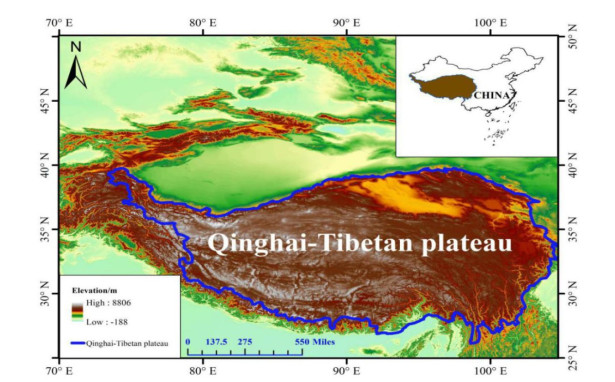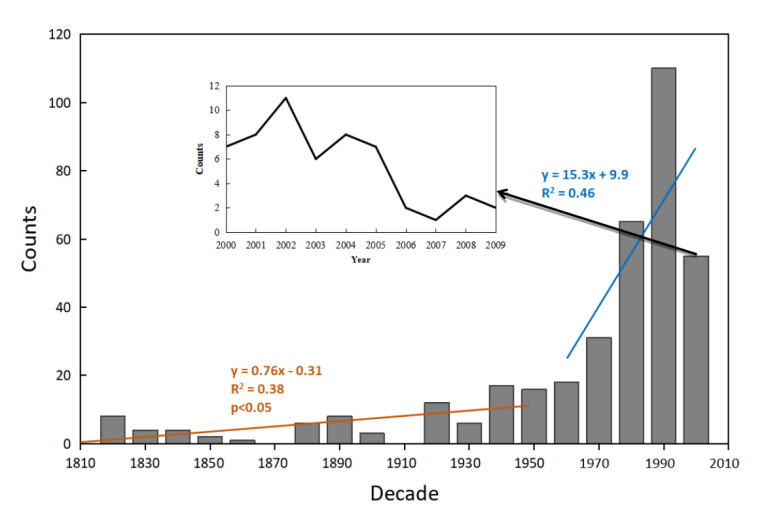1.
Introduction
Snow disaster refers to a kind of meteorological issues in winter and spring in pastoral areas, which is caused by a large amount of snowfall, continuous low temperature and prolonged snow cover [1,2], resulting in a number of livestock deaths, traffic interruption, and frostbite and even death of herdsmen. The events of snow disasters frequently happened over the central and eastern Asia, especially over the Qinghai-Tibetan Plateau, the Mongolia Plateau, and the area between Chinese Xinjiang and central Asia [3]. Previous studies have focused on characteristics of snow disaster [4,5], remote-based monitoring [6], the estimation of risk and loss [7], and early warning [8,9].
Qinghai-Tibetan Plateau is the highest and largest plateau on the earth (Figure 1), with the averaged elevation of more than 4500 m a.s.l., and an area of about 2.5 million km2. It is characterized by the annual mean temperature below 0 ℃ in the hinterland of the Plateau, and the warmest monthly mean temperature is less than 10 ℃ in the large areas [10,11]. The dominated precipitation occurs from June to September. The winter is dry and cold with strong winds. Snow disasters mainly occur from October to April of the next year [12]. Alpine grasslands are the dominant ecosystem, and animal husbandry is a pillar industry to the development of local economy, in adaptation for survival on the harsh plateau. Because of extreme climate conditions, the plateau is susceptible to frequent snow disasters in winter and spring (Figure 2). Owing to low temperature, livestock are vulnerable and easily suffer from the illness. The persistent snow cover resulting from snow disasters handicaps the livestock to find suitable foliage. As a consequence, snow disasters resulted in the deaths of exceeding 2.5 million livestock over the Qinghai-Tibetan Plateau for the 1978–2008 period [13], then pose serious threats to the sustainable development of animal husbandry. For example, on 15 February 1995, there was a heavy snow disaster event in Naqu City, Tibet Autonomous Region. The coverage area of the disaster accounts for more than 40% of the whole region. The resulting loss was 194 million CNY, of which the direct economic loss reached 96.47 million CNY. From December 2018 to March 2019, Yushu, Guluo and Haidong Districts at the southern Qinghai-Tibetan Plateau experienced the worst snow disasters of the past 50 years in Qinhai Province, China. More than 70 heavy snowfalls happened, in this event, the duration of snow cover is greater than 50 days, and even some districts greater than 75 days. In some regions, the depth of snow cover exceeds 45 cm. The disasters affected > 210000 people and killed approximate 60000 livestock. The direct economic losses are approximately 192 million CNY only three cities in one province caused. Thus, the investigation of spatial and temporal variability in snow disasters is highly required to fight against them and to reduce economical losses in the pastoral regions. Many measurements have been implemented to monitor long-term changes in the snow disasters [14,6] to assess the consequent risks [15,16]. However, these studies largely focused on snow disasters changes over the past 50 years or shorter time scales. The snow disasters in a relative long-term (i.e., century scale) is poorly investigated.
Our objectives of this study are (1) to report the historical occurrence of snow disasters over the Chinese Qinghai-Tibetan Plateau during the past 200 years, then (2) to determine whether the frequent occurrence onwards 1980 is follow a long-term variation trend. This is useful for prediction of the future frequency of snow disasters.
2.
Data and methods
We collected snow disaster data across the Qinghai-Tibetan Plateau in the 1820–2000 period to examine their decadal changes. The data were collected from the China Meteorological Disaster Ceremony: Qinhai and Tibet [12,17], for the 2001–2003 period from China Meteorological Data Sharing Service System (http://data.cma.cn/site/index.html), and for the 2004–2009 period from the Yearbook of Meteorological Disasters in China (2004–2009) [18,19,20,21,22,23]. Gridded air temperature data are derived from https://crudata.uea.ac.uk/cru/data/hrg/.
According to the Meteorological Disaster Standard of China (DB63/T372–2001) [24], and the national standard for grading snow disasters in pastoral area (GB/T20482–2006) (General Administration of Quality Supervision of China 2006) [25], snow disasters are classified based on the duration and depth of snow in terms of snow state in winter and spring from weather station observations. The threshold values are determined by comprehensively considering vulnerability of the livestock, herbage yields, carrying capacity of grassland, and so on. Snow disasters can be classified into slight, moderate, heavy and severe disasters (Table 1). For example, one snow disaster is considered as heavy class if it has an averaged depth of 2–5 cm, and meanwhile lasts for more than 40 days in winter, and over 20 days in spring, based on records of the weather stations. This often leads to herbage buried by snow in pastoral areas, and livestock cannot feed. They suffer from huger, and illness and so on, due to extremely low temperature and duration of snow cover, and as a consequence, the large number of deaths are present.
Over the Qinghai-Tibetan Plateau, the records of snow disaster events before the late 1950s come from the historical archives of natural disasters [12,17]. Since the 1950s, snow disaster events are determined mainly by snow observations from the weather stations. For their overlapping periods, the counts of snow disaster events, which belong to heavy and severe classes in the criteria (Table 1), are common for the Qinghai-Tibetan Plateau [12,17]. To keep temporal homogeneities of data, here only heavy and severe snow disaster events were compiled.
3.
Results and discussion
Snow disasters frequencies has a large year-to-year change in across the Qinghai-Tibetan Plateau, therefore short-term anomalies may result from inter-annual/decadal variability, rather than a long-term trend. To address this issue, we examine the changes in the counts of decadal snow disasters over the Qinghai-Tibetan Plateau in the 1820–2000 period (Figure 3). It is noted that there is no dramatical variation before 1960, but has a significant increase trend since the 1960s. On average, 366 snow disasters events have appeared since 1820, and 230 occur from 1980 onwards with decadal maximum (110 events), with the unprecedented occurrence over the 1990s. Based on the weather station records, previous studies reported an increase of snow disasters during the past 50 years, and most intense snow disasters are present in the 1990s over the Qinghai-Tibetan Plateau [26,27,28].
The increased snow disasters in recent decades may be related to climate variability over the Qinghai-Tibetan Plateau. Previous studies have reported climate warming beginning in the mid-1950s (warming rate: 0.16–0.36 ℃ decade-1), and the warming rate significantly increase since the mid-1980s (0.50–0.67 ℃ decade-1) [29]. In particular, significant warming in winter since the 1960s (0.46 ℃ decade-1) is higher than that of the other regions in China [30]. Because of key role of air temperature in the changes in snowfall over the Qinghai-Tibetan Plateau [31], the heavy and extreme snowfall and the number days of heavy and extreme snowfall show obvious upward trends during 1961–2017 [32]. Generally, the rising temperatures can intensify hydrological cycle and energy budge through the enhancement of evaporation and the moisture transport. Increased evaporation and moisture supply leads to more frequent and intense storms, and thus more snow events [33]. The number of decadal snow disaster also shows a significant correlation with mean temperature averaged over the plateau (r = 0.74, p < 0.05). Huang et al. [28] found that when more snow disasters occur on the Qinghai-Tibetan Plateau, the polar vortex in the eastern hemisphere is stronger and the East Asian Trough is westward, which is conducive to the southward movement of the northern cold air. The south branch of the westerly belt is active frequently and the subtropical high is to the west, which transports abundant water vapor in the south. The polar vortex and the south branch of the westerly belt enhance from the 1960s to the end of 1990s when significantly warming occurs, but they tend to decline from 1998 onwards when the warming hiatus is present [28]. These seem to show that decadal snow disaster counts may increase in the context of accelerated climatic warming.
When defining snow disaster, vulnerability of the livestock and people is taken into account. During the past 50 years, population and livestock numbers have experienced a significant increase, particularly from 1965 to the 1980s, with a growth rate of higher than 35% [34]. With the increase of herbage yields, carrying capacity of grassland decreases. As a result, the livestock are more vulnerable to snow disasters. However, the number of snow disaster decline during the 2000s, which may be attributed to the contribution of the enhanced protective measures by Chinese governments, and improved prediction of meteorological hazards [16]. As shown in Figure 3, the number of annual snow disasters presents a downward trend during the 2000s. According to our statistics, the total number of snow disasters from 2000 to 2009 was 55, which is significantly less than the number of snow disasters in the 1990s, but still more than the number of decadal snow disasters before the 1970s. Some studies found that the number of snow disaster on the Tibetan Plateau has decreased since the first decade of the 21st century, which is consistent with our statistical results [6,31].
4.
Conclusions
Qinghai-Tibetan Plateau has long been exposed and vulnerable to snow hazards. Significant upward trends are observed in the snow disasters frequencies from the 1960s onwards. As a consequence, in the last three decades, there are 230 snow disasters events with the maximum during the 1990s, which is unparalleled during the past 200 years. The significant increased snow disasters may be associated with the rapid regional warming. According to IPCC (2019) [35], over the 21st century, atmospheric warming at the rate of at least 0.3 ℃ decade-1 is projected to continue over the Qinghai-Tibetan Plateau, regardless of the climate scenario. This means that the occurrence of snow disasters might rise over the 21st century.
Acknowledgments
This work was supported by the National Natural Science Foundation of China: 41971081, the Strategic Priority Research Program of the Chinese Academy of Sciences: XDA19070103 and the Project for Outstanding Youth Innovation Team in the Universities of Shandong Province: 2019KJH011.
Conflict of interest
The authors declare no conflict of interest.










 DownLoad:
DownLoad:





